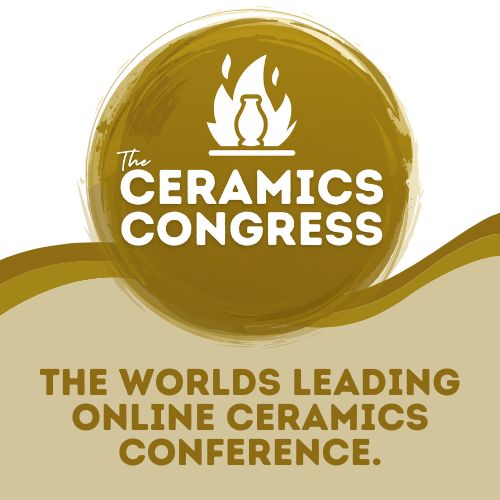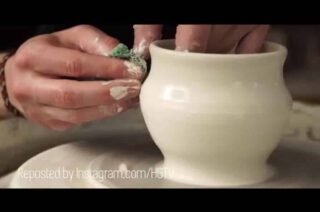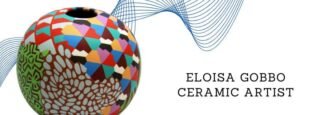As a maker, you know that keeping the creative juices flowing often requires more than just talent and passion; it calls for an environment that nurtures innovation and inspiration. If you’re lucky, you’ve been able to find this in your home studio, or communal space with other makers you vibe with. But sometimes this can be hard to come by. Maybe your studio is too small for the work you want to make, the community studio’s hours too restrictive. Or maybe distractions at work or at home make it hard to find time and focus. If this is the case, then an artist residency may be just the thing you need!
Whether you’re looking to hone your craft, seeking fresh perspectives, or looking to recharge your creative batteries, ceramic residencies are an option worth considering. And, if you’ve been thinking of applying for a program but haven’t been sure where to start, we’re here to help! We’ll look at the different types of ceramic residencies, the application process, important considerations, as well as the transformative experiences residencies can offer. Join us as we delve deep into this immersive world where artists from all walks of life come together to push the boundaries of their creativity.

What Exactly are Ceramic Artist Residencies Anyways?
To those who aren’t familiar with artist residencies, they’re opportunities to go to a new location for a set period of time to explore your practice without distraction. They can take many forms and durations, with a wide range of requirements, offerings, supports, and expenses. We’ll dive into all those in a moment, but the main thing to know is that they give you the time and space you need to focus exclusively on your practice. For many artists they can be turning points, introducing them to new perspectives or processes, allowing them to deep dive into research projects, and introducing them to other artists from across the country or around the world. If you feel as though you’ve been stagnating in your growth, they can help you jumpstart new ideas and give you space to play and experiment.

the largest ceramics residency in Europe
Main Types of Residencies
Residencies are structured in many different ways, so there’s definitely one out there to fit your practice, schedule, and budget! We’ll outline the most common types below, so you can get a sense of what’s on offer.
Self-Directed Ceramic Residencies
Probably the most common type of residency is the self-directed one, where the residency provides you with workspace and (usually) living space. There will be a program coordinator, who may or may not be on site, but you are free to work however you like, provided it fits within their mandate. Some programs will expect physical output and a very clear plan, while others recognize the need to step back, recharge, and do pure research and reflection with no physical output needed. Usually, you’ll outline your project goals in your application, and will be expected to roughly stick to these. However, deviation from the initial plan is common as you respond to the new inspirations that the residency provides, so don’t worry if things change a bit once you’re there!
Self-directed residencies focus on creative independence, though some are more rigid in their expectations than others. We’ll go into more detail on common requirements a little later on, but to give you a quick sense of things, you may be expected to give a talk or workshop to the community, exhibit the work created during your stay, or take part in an open studio day.
Thematic Ceramic Residencies
Thematic residencies require you to make work around – you guessed it – a specific theme. This can be very broad, such as exploring the global climate crisis, gender in art, or issues of decolonization. They can also be very specific, such as responding to the city or environment in which the residency takes place, a particular collection in a museum, or a specific historical event. In other instances, they may require you to be from a specific place, or of a certain heritage or under-represented group, as their aim is to support such people. The structure of thematic residencies varies greatly, with some offering relevant artist talks and mentors, others requiring collaboration with the other artists, while still others are quite loose and more closely modeled after self-directed programs.
Typically, thematic residencies require you to demonstrate that you’ve already been exploring the specified topic in your work. Don’t let this deter you from applying though. If the residency explores something you’ve long been interested in but haven’t yet explored, go for it! Tell them why the residency is a good fit for you and how the program will help you start your investigations. For residencies that require a local focus, research the location and find something that connects to your practice. Are there environmental concerns that relate to your work? Archaeological sites that excite your interest in history? Or a local ceramic process that is unique and has something to offer your work?
Medium-Focused Residencies
These residencies are for artists who either presently work in a specific medium or who would like to learn a new one, usually the former. As ceramic artists, this type is probably the most sought-after, as we require specialized facilities to do what we do. These programs are fantastic if you need access to facilities or equipment that you don’t have at home, such as wood fire kilns, large-scale car kilns, or a dedicated plaster room. This type of residency will often have trained technicians on hand to help you realize your project. They can help you learn a new process, teach you how to fire an unfamiliar kiln-type, or advise you on the best local clay body for your idea.
These programs can be set up as self-driven or thematic residencies. To make the most of their facilities and technicians, they typically accommodate groups of artists at a time, versus having solo options. This is beneficial though, as your fellow resident artists will be there to share their experiences and processes, and you can do the same for them.
Social Engagement Based Residencies
These residencies require your project to contribute to the local community in a meaningful way. This can range from engaging with local schools, creating a public art event, or hosting a workshop for a specific demographic. Typically you’ll also have time for personal work, but the emphasis is on raising the visibility of art within the community, and supporting under-privileged groups who have less access to creative opportunites. These residencies tend to be shorter in length, and are geared towards artists whose practice is publicly or socially focused.
Exhibition Residencies
While many residencies offer the opportunity to develop work for future exhibitions, or to exhibit your work at the end of the program, there are some where exhibiting is the primary goal and focus. You’ll be expected to outline and execute a specific project, often at a gallery or museum, which will culminate in a show at the residency location. Usually these programs support one artist at a time for a solo show, but sometimes they’re targeted towards group shows of 3-4 makers. In some cases, the exhibition occurs immediately at the end of the residencies, while others give you time to go back to your own studio for further work before the exhibition date. These programs can be great if the lack of dedicated time has held you back from applying for exhibition opportunities.
Ceramic Artist-in-Residence Programs
These are longer programs of 6 months to 3 years, and are usually found at larger art centers, museums, and universities. They are fantastic opportunities for deep-diving into large research projects, and will often come with stipends, exhibitions, and teaching opportunities.
Many residencies bridge a number of these categories, and some defy traditional definition. Be sure to have a thorough read-through of their program and mandate so you know what to expect with each residency, and if it’s a good fit for you.

with local indigenous populations in remote locations
Where Can I Find Ceramic Residencies?
The simple answer to this is: almost anywhere! Artist residencies are available around the world. They can take place in pretty much any environment you can imagine, such as wilderness locations, small villages, remote islands, large urban centers, and even research vessels and cargo ships. They can be hosted by a variety of institutions including craft councils, museums, city councils, national or state/provincial parks, scientific research facilities, and even hospitals. And there are, of course, ones that are run from purpose-built facilities and artist-run centers. As ceramicists, you’ll most likely be seeking out those with dedicated ceramic facilities, but don’t overlook some of the alternative options, as they have great potential to push your work in new directions.
You can find residency opportunities in a number of ways. The first is a simple google search for “artist residencies” or “ceramic residencies.” Another great place is on your craft/arts council website or newsletter, as they’ll commonly be included in the opportunities section. If you are looking for a broader view of offerings, your best bet is to check out artist opportunity and residency directories.
Here’s a short list to get you started:
The Ceramic School Directory: We’re currently building a comprehensive residency directory for you that focuses specifically on programs that support ceramic artists.
ResArtis.org: An international residency organization, with a great web feature that allows you to streamline your search by medium, facilities, and country.
TransArtists.org: One of the largest residency directories available, covering all media.
Artist Communities Alliance: Another international residency directory, this one also includes a funding directory to help you find ways to cover your program costs.
Curator Space: This platform focuses on all types of artist opportunities, with residencies frequently being posted. There’s a British focus, but many of the residencies are open to international applicants.

introduces you to the unique Talavera majolica process of the region
What are the Benefits?
We’ve already hit on some of the main benefits of going to residencies, such as focused time for idea development and project completion, but there are lots of hidden benefits to going to residencies as well!
One of the biggest benefits is the opportunity to meet artists from around the world. You’ll be in contact with people from a broad range of backgrounds and practices, as excited as you to be embarking on this new experience. Life-long friendships commonly develop out of residencies, and inspiration is never in short supply.
Another huge benefit is that it gives you the opportunity to travel and see the world in a different way than typical tourism. You’ll be living in a new place with a home base, mingling studio time with exploration. You’ll also likely have the opportunity to interact with locals (as residencies are usually run by local people!), and with other participants who will be experiencing this new place right along with you. This is great for you as a maker, as several studies indicate that travel, especially living abroad for a period of time, increases creativity! Depending on the program, it can also be a very affordable way to see the world, as housing is commonly included in your fee.
The program may give you access to equipment you don’t have access to at home, along with providing technicians to teach you how to use it. This can range from 3D printers and CNC machines, to different kiln types, or sandblasters and spray booths. It’s an opportunity to complete project ideas that require these tools, or to simply try them out and see how your work evolves.
Another possible benefit is the opportunity to work with professionals in other fields, such as science or conservation. An excellent example of this is the residency at CERN, where artists of all media have the opportunity to work alongside physicists to create works in response to the research being done at the facility. If your work is engaged with specific research areas, opportunities such as this can be invaluable. You can also find residencies with professionals in fields adjacent to your focus, such as the one at the Kohler factory, where you can make ceramic works in the context of industrial ceramics.
These are just a few of the benefits you can experience at artist residencies. Everyone’s experience is unique, and we’re sure you’ll find some that we haven’t included!

Things to Consider
Once you know what type of residency would be a good fit or an exciting opportunity, it’s time to look at the specifics. As we’ve mentioned, residencies can take different forms, so we recommend looking at these variables before you start your application.
The Size of the Cohort
One of the overarching variations is the number of other participants. Residencies can be very community focused with upwards of 20 artists participating at a time, or they can offer complete solitude, and of course everything in between.
With group formats, you have the freedom to intermingle or collaborate as much or as little as you like. Generally the cultivation of community is encouraged, and things like shared meal prep and eating, gallery visits, and group outings, are common. Some residencies are organized so that groups of artists all arrive at the same time, while others feature a rolling intake, with people coming and going at various times during your stay. Many artists come away from these residencies with life-long friendships, new creative connections, and even new professional collaborations.
With solo residencies, you have complete freedom over your schedule, with few distractions or interruptions. This can be lovely if you are needing a break from the high-demands of work and family, or if you’re the type whose creativity thrives in the quiet. With solo residencies located in nature, you may require a car (or at least a driver’s license) for grocery and supply runs, though sometimes the residency will arrange weekly transportation for this purpose.
When researching residencies, be honest with yourself about which type of environment will be most helpful at this point in your practice: are you looking for others to help bounce ideas off of, be inspired by, and break the isolation of the home studio? Or are you looking for a peaceful getaway where you can enjoy some solitude, with just yourself and your practice for company?
Cost
Cost is probably your biggest concern when it comes to choosing a residency, and it definitely varies widely. There are many residencies that will actually pay you a stipend (we love these ones!), but the competition tends to be higher due to increased applications. Don’t let this deter you, simply keep it in mind to manage your expectations. More commonly, program fees range from about $200-$800USD/week, depending on the facilities and support on offer.
One thing that’s important to keep in mind is that the residency fee is only part of your true expense. You’ll have to cover the cost of your travel to and from your home to the residency, any travel during the residency, your supplies, your food, museum entry fees, and the cost of shipping your work home at the end (an important one not to overlook as a ceramic artist!). In some cases, housing is not provided, so you’ll have to factor this in as well. Before applying it’s worth creating a thorough budget to get a clear picture of what you’re getting looking at. A program that looks like it’s only $600/month can easily be double that in reality.
If the potential costs are deterring you from applying, remember that many funding bodies have grants specifically to support residency participation. They recognize the value that these programs bring to the artist and the arts community at large, and are set up to help. They can fund your residency in part or in full, so research to see if you’re eligible. You may be able to go at very little cost at all!
Accessibility
This is an important consideration on a couple of levels. If you have a disability, you’ll definitely want to check that the facility can accommodate you. It’s not uncommon for programs to take place in historic or alternative buildings without easy entry or elevators. Reach out to the program coordinator to address any concerns before you apply. They may have retrofits in place to support you, or have alternative solutions. Another accessibility consideration is the location and access to public transit. Some residencies, especially those that aim to foster solitude, can be in remote locations. If you don’t drive, these may not be options for you. Check with the residency to see if they offer transport support before you apply.
Duration
Residencies can vary a lot in length, and it’s an important consideration with regards to work, obligations at home, the type of project you want to do, and your medium. Residencies can be as short as a weekend or as long as 3 years, but the average is between 2-4 weeks. With ceramics, time is one of the most important elements of what we do, so keep this in mind when deciding on a program. If you want to produce finished clay pieces, consider ones that are 3 weeks or longer. If you are more focused on research and idea development, then shorter options can be great.
Facilities
This is obviously a big one for us as ceramic artists! If you intend to create ceramic works during your residency, make sure they have the equipment you need. One thing we’ve noticed on some of the larger residency search platforms is that often programs will say they support ceramics, but when you look at their facilities, there’s no kiln in sight! If you’re interested in a residency where this seems to be the case, send them an email to confirm. In some cases they don’t have a kiln themselves, but have relationships with artists in the community whose facilities you’ll have access to. Just as often though, non-clay focused programs simply overlook this requirement!
Many residencies have multiple specialized spaces available, such as ceramic studios, woodshops, and print studios. These programs are great if you want to incorporate new processes into your practice. In other cases, residencies offer only general studios, best suited to researching, drawing, digital projects, or sculpture.
You’ll also want to check if housing is included with the program, along with kitchen facilities. In some cases you’ll have private accommodations, while in others it will be shared. If no accommodation is provided, check to see if they have links to housing options in the community to support you in your search.
Expectations of the Artist
While many residencies come only with the expectation that you’ll develop your practice and roughly follow your project plan, many do come with specific requirements. Most commonly, these include things like giving an artist talk, being present in the studio a set number of hours per day, participating in open studio days, giving workshops, donating a piece of work to the organization at the end, or doing an exhibition. Make sure you read the requirements carefully so you know what you’re expected to contribute.
Application Tips
The first recommendation we have for you is to make sure you read the residency mandate and requirements carefully. You want to be sure that you fit what they’re looking for, and that the program is a good fit for you. Don’t forget to consider the dates of the program, language requirements, and visa restrictions if it’s in a foreign country.
Once you’re confident you’ve found a great fit, have a careful readthrough of their application form. Many require you to have a clear project in mind, and some will need a weekly work plan to show how you’ll make the most of your stay. Follow all document length requirements carefully, and pay special attention to any file naming guidelines and image size specifications. You’ll likely need to attach your CV and artist statement, so have those up to date as well. If you need a hand with your statement, head on over to our blog post on the subject to get some great tips! Lastly, make sure your images are high quality, and choose works that are most relevant to your project proposal. For tips on how to photograph your work, check out our in-depth guide here.
Another great idea for preparing your application is to do some research on the region the residency is in. This is particularly important if the program has a local focus, but even if it’s not, it can help to mention why this particular place is the place for you. Is there something about their facilities, ideology, city, or natural environment that adds something to your project that wouldn’t be possible elsewhere? Incorporating this into your application will show that you’re truly invested in coming, and that you’ve taken the decision to apply seriously.

As we wrap up our overview, it’s clear that whether you’re eager to refine your skills, yearning for new perspectives, or simply looking to rekindle your creative fire, ceramic artist residencies offer a dynamic solution to your creative needs. They provide an escape from the confines of your daily routine, allowing your artistic practice to flourish in new and unexpected ways. If you’ve been on the fence about taking the plunge into the world of residencies, we encourage you to take that leap! These experiences promise to stretch your creative boundaries and leave an indelible mark on your artistic practice.
To help you find that perfect residency, remember to check out The Ceramic School Directory. We’re continually expanding our database of ceramic-friendly programs, and are sure to have something that will fit your needs! And if you’ve already participated in a residency or two, be sure to share your experience with us in the comments below!






Responses